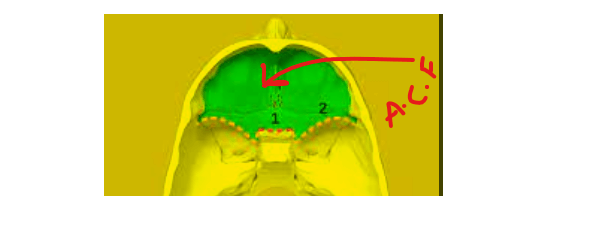Quick Overview
The Anterior Cranial Fossa is one of the three cranial fossae, or depressions within the base of the skull, that houses and protects different parts of the brain. It is situated at the front and lower region of the cranial vault, and plays a vital role in cradling and safeguarding the brain’s frontal lobes.

Table of Contents
Anatomy of Anterior Cranial Fossa
It is a concave space formed by several cranial bones, including the frontal bone, ethmoid bone, and the lesser wings of the sphenoid bone. Its complex structure is integral to its functions.
Location
It is located at the front of the skull, above the eyes and nose. It is bounded by the frontal bone superiorly, the ethmoid bone medially, and the sphenoid bone inferiorly.
Boundaries
Following bones make the boundaries ;
- Superiorly: Frontal bone
- Medially: Ethmoid bone
- Laterally: Frontal bone, sphenoid bone
- Inferiorly: Sphenoid bone
Structures
The structures found within the fossa are;
- Frontal lobes of the brain
- Olfactory bulbs
- Olfactory tracts
- Optic chiasm
- Anterior cerebral arteries
- Anterior communicating artery
- Cribriform plate of the ethmoid bone
- Crista galli of the ethmoid bone
- Lesser wings of the sphenoid bone
Read also Cubital fossa : Anatomy, Borders, Contents
Functions
The primarily function is to serve as a protective barrier for the frontal lobes of the brain, shielding them from external forces and potential injuries. It also accommodates and provides support to the olfactory bulbs and tracts, crucial for our sense of smell.
Clinical Significance
It is susceptible to a number of injuries and conditions, including;
- Head trauma
- Skull fractures
- Brain tumors
- Meningitis
- Hydrocephalus
Damage to the structures in the anterior cranial fossa can lead to a variety of neurological problems, including;
- Loss of consciousness
- Coma
- Memory loss
- Difficulty thinking
- Vision problems
- Loss of smell
- Personality changes
Associated Conditions
1- Frontal Sinus Fractures: Trauma to the forehead area can lead to fractures of the frontal sinus, which is located within the anterior cranial fossa.
2- Olfactory Nerve Disorders: The olfactory nerves responsible for the sense of smell pass through this fossa. Conditions affecting these nerves can lead to loss of smell or altered perception.
3- Anterior Skull Base Tumors: Various types of tumors, including benign and malignant growths, can develop in the anterior skull base, affecting the surrounding structures and requiring surgical intervention.
4- Cerebrospinal Fluid (CSF) Leak: A fracture or injury to the anterior cranial fossa can result in a cerebrospinal fluid leak, which can lead to complications like meningitis if not properly treated.
5- Mucoceles: Mucoceles are cyst-like structures that can develop in the frontal sinus, leading to pressure and discomfort within the anterior cranial fossa.
6- Frontal Encephaloceles: These are rare congenital malformations where brain tissue protrudes through a defect in the anterior cranial fossa’s bony structure.
Question
Q: What are the symptoms of an anterior cranial fossa injury?
The symptoms depends on the severity of the injury and the structures that are affected. Common symptoms include:
1- Loss of consciousness
2- Coma
3- Headache
4- Dizziness
5- Nausea and vomiting
6- Confusion
7- Memory loss
8- Difficulty thinking
9- Vision problems
10- Loss of smell
11- Personality changes
If you experience any of these symptoms after a head injury, it is important to see a doctor right away.
Q: What are the risk factors for an anterior cranial fossa injury?
1- The risk factors for an anterior cranial fossa injury include:
2- Participating in contact sports
3- Engaging in dangerous activities, such as motorcycle riding or rock climbing
4- Falling from a height
5- Being in a car accident
6- Being assaulted
Q: How is an anterior cranial fossa injury diagnosed?
Diagnosis is based on a physical examination and the patient’s medical history. Imaging tests, such as a CT scan or MRI, may be ordered to confirm the diagnosis and assess the severity of the injury.
Q: How is an anterior cranial fossa injury treated?
The treatment depends on the severity of the injury and the structures that are affected. Mild injuries may be treated with rest, ice, and pain medication. More severe injuries may require surgery.
Q: What is the prognosis for an anterior cranial fossa injury?
The prognosis for an anterior cranial fossa injury depends on the severity of the injury and the structures that are affected. Some people make a full recovery, while others experience long-term neurological problems.
